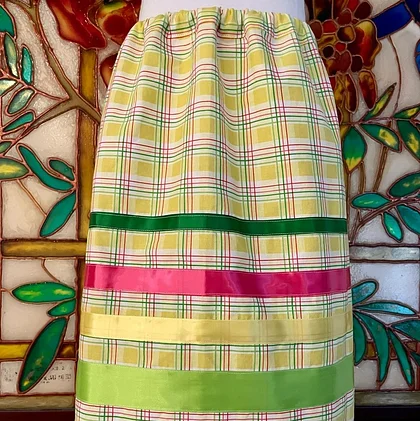Native American ribbon skirts are not merely pieces of clothing; they are vibrant expressions of cultural identity, heritage, and artistry. Worn by women across various tribes, these skirts serve as a symbol of tradition and resilience, reflecting the rich histories and unique stories of Native communities. Each skirt is adorned with colorful ribbons that represent different meanings, often tied to the wearer's clan or personal experiences, adding a layer of personal significance to the garment.
The creation of ribbon skirts involves intricate craftsmanship and deep cultural understanding. Artisans carefully select fabrics and ribbons, often incorporating themes and colors that resonate with their heritage. The process of making ribbon skirts not only showcases artistic skill but also fosters community bonds, as many women gather to share techniques, stories, and teachings. As the skirts are worn at ceremonies, tribal gatherings, and celebrations, they embody a living tradition that connects generations and honors the strength of Native American women.
Cultural Origins and Symbolism
The tradition of ribbon skirts among Native American communities has deep cultural origins, tracing back to the Plains tribes. Historically, these skirts were crafted as a reflection of the creator's identity and the community’s values. Each garment was unique, often fashioned from colorful fabrics and adorned with ribbons, representing the connection to nature and individuality. learn more were not only visually striking but also held significance, symbolizing various aspects of life, spirituality, and heritage.
In many tribes, ribbon skirts are worn during ceremonies and special occasions, serving as a testament to the richness of Native American culture. They embody the stories and experiences of the women in the communities, marking important life events such as coming-of-age ceremonies, weddings, and powwows. The act of wearing a ribbon skirt is more than a fashion statement; it is a demonstration of pride in one’s heritage and a way to carry forward traditional practices through generations.
Furthermore, the symbolism embedded in ribbon skirts extends beyond their aesthetic appeal. They often signify a connection to ancestral roots and serve as a medium for storytelling. The patterns and designs incorporated into each skirt can convey messages of resilience, strength, and unity among Native peoples. As contemporary designers continue to draw inspiration from traditional methods, ribbon skirts remain a powerful emblem of cultural identity, bridging the past with the present and empowering the future.
Materials and Techniques
The creation of Native American ribbon skirts involves a careful selection of materials that reflect both cultural significance and individual expression. Traditionally, cotton fabric serves as the primary base material, prized for its durability and comfort. The choice of color and pattern is also vital, as each hue can symbolize various aspects of nature, spirituality, or tribal identity. Ribbons, which are added for decoration, come in a multitude of colors and widths, allowing artisans to personalize their skirts while honoring traditional designs.

Artisans employ a variety of techniques in the construction of ribbon skirts. The assembly process often starts with measuring and cutting the fabric to achieve the desired length and silhouette. Many artists choose methods that celebrate their heritage, such as hand sewing or intricate beading, which add depth and texture to the finished piece. The incorporation of ribbons is done thoughtfully, with styles varying from simple linear designs to elaborate patterns that tell a story or convey meaning.
As the craft evolves, some contemporary makers incorporate modern materials and techniques, while still respecting the traditional roots of ribbon skirts. The use of machine sewing can increase production speed, yet many artisans prioritize hand-crafted elements to maintain authenticity. This blending of old and new reflects the dynamic nature of Native American cultures, showcasing how traditional art forms continue to grow and adapt within modern contexts.
Contemporary Significance and Trends

In recent years, Native American ribbon skirts have gained increased visibility and appreciation within both indigenous and non-indigenous communities. These garments are celebrated not only for their aesthetic beauty but also for their powerful representation of cultural identity and resilience. Young Native women and girls are particularly drawn to ribbon skirts as a means of reconnecting with their heritage, allowing them to express pride in their ancestry while embracing modern fashion trends. Social media platforms have played a crucial role in this resurgence, as artisans showcase their designs, share personal stories, and spark conversations about cultural significance.
The use of ribbon skirts has also expanded beyond traditional settings, with contemporary interpretations bringing new life to this age-old art form. Designers are experimenting with different materials, colors, and styles, creating unique pieces that resonate with current fashion sensibilities while still paying homage to traditional techniques. This blending of the old and new fosters a dynamic dialogue surrounding Native American identity, encouraging a broader audience to engage with and appreciate the craftsmanship involved in making ribbon skirts. Fashion shows, workshops, and cultural events highlight these creative developments, solidifying the role of ribbon skirts as essential elements of contemporary Native fashion.
Moreover, the empowerment of indigenous voices in the fashion industry continues to challenge stereotypes and promote a deeper understanding of Native American cultures. Increased collaboration between Native artisans and non-indigenous designers is helping to create a greater appreciation for the artistry behind ribbon skirts. By highlighting the stories and traditions that inform each piece, these collaborations contribute to a growing movement that honors and respects indigenous heritage. As ribbon skirts remain a vital expression of identity, their significance will likely continue to evolve, bridging past and present in a vibrant tapestry of cultural expression.
